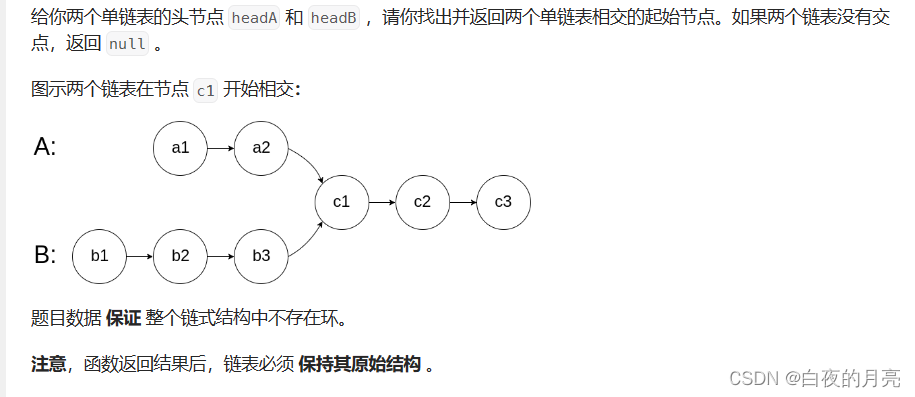算法(二)——数组章节和链表章节
数组章节
(1)二分查找
给定一个 n 个元素有序的(升序)整型数组 nums 和一个目标值 target ,写一个函数搜索 nums 中的 target,如果目标值存在返回下标,否则返回 -1。
class Solution {public int search(int[] nums, int target) {//二分查找法int right=nums.length-1;int left=0;while(left<=right){int mid=(right+left)/2;if(target<nums[mid]){right=mid-1;}else if(target>nums[mid]){left=mid+1;}else{return mid;}}return -1;}
}
(2)双指针——移除元素
- 给你一个数组 nums 和一个值 val,你需要 原地 移除所有数值等于 val 的元素,并返回移除后数组的新长度。
- 不要使用额外的数组空间,你必须仅使用 O(1) 额外空间并 原地 修改输入数组。
- 元素的顺序可以改变。你不需要考虑数组中超出新长度后面的元素。
class Solution {public int removeElement(int[] nums, int val) {//双指针(quick-遍历数组 slow-将不等于val的元素依次插入新数组)int slow=0;for(int quick=0;quick<nums.length;quick++){if(nums[quick]!=val){nums[slow]=nums[quick];slow++;}}return slow; //slow指针指向空位,等待插入,所以slow值等于新数组长度}
}
(3)有序数组的平方
给你一个按 非递减顺序 排序的整数数组 nums,返回 每个数字的平方 组成的新数组,要求也按 非递减顺序 排序。
class Solution {public int[] sortedSquares(int[] nums) {// 结果数组int n = nums.length;int[] result = new int[n];// 双指针int left = 0;int right = n - 1;while (left <= right) {if (Math.pow(nums[left], 2) >= Math.pow(nums[right], 2)) {result[n - 1] = (int) Math.pow(nums[left], 2);left++;} else {result[n - 1] = (int) Math.pow(nums[right], 2);right--;}n--;}return result;}
}
(4)长度最小的子数组
- 给定一个含有 n 个正整数的数组和一个正整数 target 。
- 找出该数组中满足其总和大于等于 target 的长度最小的 连续子数组 [numsl, numsl+1, …, numsr-1, numsr] ,并返回其长度。如果不存在符合条件的子数组,返回 0 。
class Solution {public int minSubArrayLen(int target, int[] nums) {int res = 2147483647;//整数最大值int len;int sum=0;int i=0;//i 为窗口开始位置,j 为窗口终止位置for(int j=i;j<nums.length;j++){sum+=nums[j];while(sum>=target){len=j-i+1;res=Math.min(len,res);sum-=nums[i++];//不断移动i,直到区间内的和< target}//跳出while循环后,遍历继续j,j指针重新与i指针合并}return res==2147483647? 0:res;//数组总和都达不到target,res没有改变}
}
(5)螺旋矩阵
给你一个 m 行 n 列的矩阵 matrix ,请按照 顺时针螺旋顺序 ,返回矩阵中的所有元素。
class Solution {public List<Integer> spiralOrder(int[][] matrix) {//这个二维数组行列不确定List<Integer> result = new ArrayList<>();//matrix.length 行数//matrix[0].length 列数if (matrix == null || matrix.length == 0 || matrix[0].length == 0) {return result;}int rows = matrix.length; //行int cols = matrix[0].length; //列//定义四个变量top、bottom、left、right,分别表示当前遍历的上边界、下边界、左边界和右边界。//初始时,上边界为0,下边界为行数减1,左边界为0,右边界为列数减1。int top = 0, bottom = rows - 1, left = 0, right = cols - 1;while (top <= bottom && left <= right) {// 从左到右if(right!=0){ //判断只有一列的情况for (int i = left; i <= right; i++) {result.add(matrix[top][i]);}top++;}// 从上到下if(bottom!=0){//判断只有一行的情况for (int i = top; i <= bottom; i++) {result.add(matrix[i][right]);}right--;}// 从右到左if (top <= bottom) {for (int i = right; i >= left; i--) {result.add(matrix[bottom][i]);}bottom--;}// 从下到上if (left <= right) {for (int i = bottom; i >= top; i--) {result.add(matrix[i][left]);}left++;}}return result;}
}
链表章节
(6)移除链表中的元素
给你一个链表的头节点 head 和一个整数 val ,请你删除链表中所有满足 Node.val == val 的节点,并返回 新的头节点 。
/*** Definition for singly-linked list.* public class ListNode {* int val;* ListNode next;* ListNode() {}* ListNode(int val) { this.val = val; }* ListNode(int val, ListNode next) { this.val = val; this.next = next; }* }*/
class Solution {//该方法没有头结点public ListNode removeElements(ListNode head, int val) {// 处理头节点为需要删除的节点的情况while (head != null && head.val == val) {//这个while需要注意head = head.next;}// 处理链表为空的情况(你前面持续删除首结点,当然得判断链表是不是被你删空嘞)if (head == null) {return head;}// 遍历链表,删除节点ListNode cur = head;while (cur.next != null) {if (cur.next.val == val) {cur.next = cur.next.next;} else {cur = cur.next;}}return head;
}
}
(7)设计链表
定义一个双链表,并实现它的基本操作
//双链表class ListNode{int val;ListNode next;ListNode prev;ListNode(){}ListNode(int val){this.val=val;}}
class MyLinkedList {//链表长度int size;//虚拟头结点ListNode head;public MyLinkedList() {size = 0;head = new ListNode(0);head.next = null;head.prev = null;}//根据索引查询并返回元素public int get(int index) {if (index < 0 || index >= size) {return -1;}ListNode curr = head;for (int i = 0; i <= index; i++) {curr = curr.next;}return curr.val;}//头插法public void addAtHead(int val) {ListNode newNode = new ListNode(val);newNode.next = head.next;newNode.prev = head;if (head.next != null) {head.next.prev = newNode;}head.next = newNode;size++;}//尾插法public void addAtTail(int val) {ListNode newNode = new ListNode(val);ListNode curr = head;while (curr.next != null) {curr = curr.next;}curr.next = newNode;newNode.prev = curr;size++;}//按索引添加新结点public void addAtIndex(int index, int val) {if (index < 0 || index > size) {return;}if (index == 0) {addAtHead(val);return;}if (index == size) {addAtTail(val);return;}ListNode newNode = new ListNode(val);ListNode curr = head;for (int i = 0; i < index; i++) {curr = curr.next;}newNode.next = curr.next;newNode.prev = curr;curr.next.prev = newNode;curr.next = newNode;size++;}//按索引删除结点public void deleteAtIndex(int index) {if (index < 0 || index >= size) {return;}ListNode curr = head;for (int i = 0; i < index; i++) {curr = curr.next;}curr.next = curr.next.next;if (curr.next != null) {curr.next.prev = curr;}size--;}
}/*** Your MyLinkedList object will be instantiated and called as such:* MyLinkedList obj = new MyLinkedList();* int param_1 = obj.get(index);* obj.addAtHead(val);* obj.addAtTail(val);* obj.addAtIndex(index,val);* obj.deleteAtIndex(index);*/
(8)翻转链表
给你单链表的头节点 head ,请你反转链表,并返回反转后的链表。
/*** Definition for singly-linked list.* public class ListNode {* int val;* ListNode next;* ListNode() {}* ListNode(int val) { this.val = val; }* ListNode(int val, ListNode next) { this.val = val; this.next = next; }* }*/
class Solution {public ListNode reverseList(ListNode head) {//双链表ListNode cur=head;ListNode pre=null;ListNode temp=new ListNode();while(cur!=null){temp=cur.next;cur.next=pre;//这两步不能颠倒pre=cur;cur=temp;}return pre;}
}
(9)两两交换链表中的结点
给你一个链表,两两交换其中相邻的节点,并返回交换后链表的头节点。你必须在不修改节点内部的值的情况下完成本题(即,只能进行节点交换)。
/*** Definition for singly-linked list.* public class ListNode {* int val;* ListNode next;* ListNode() {}* ListNode(int val) { this.val = val; }* ListNode(int val, ListNode next) { this.val = val; this.next = next; }* }*/
class Solution {public ListNode swapPairs(ListNode head) {ListNode demo=new ListNode();//虚拟头结点demo.next=head;//让虚拟头结点指向head首结点ListNode cur=demo;//遍历指针ListNode first;//保存需要交换的第一个结点ListNode second;//保存需要交换的第二个结点ListNode temp;//临时变量存储结点//开始遍历while(cur.next!=null && cur.next.next!=null){//分别考虑链表长度为偶数和奇数情况first=cur.next;second=cur.next.next;//开始交换位置temp=cur.next.next.next;//保存第二组结点的第一个结点//开始交换cur.next=second;second.next=first;first.next=temp;//cur需要变到下一组的前面结点cur=first;//注意此时链表的顺序以及改变}return demo.next;}
}
(10)删除链表的倒数第n个结点
给你一个链表,删除链表的倒数第 n 个结点,并且返回链表的头结点。
/*** Definition for singly-linked list.* public class ListNode {* int val;* ListNode next;* ListNode() {}* ListNode(int val) { this.val = val; }* ListNode(int val, ListNode next) { this.val = val; this.next = next; }* }*/
class Solution {public ListNode removeNthFromEnd(ListNode head, int n) {//虚拟头结点ListNode demo=new ListNode(-1);demo.next=head;//双指针法ListNode slow=demo;ListNode fast=demo;//fast首先走n + 1步 //因为只有这样同时移动的时候slow才能指向删除节点的上一个节点(方便做删除操作for (int i = 0; i < n ; i++){fast=fast.next;}//双指针开始同步右移while(fast.next!=null){fast=fast.next;slow=slow.next;}//此时slow指针指向倒数第N+1个结点//开始删除slow.next=slow.next.next;//这里返回的是demo.next而不是head;return demo.next;}
}
(11)链表相交
"双指针法"具体步骤如下:
- 创建两个指针p1和p2,分别指向两个链表的头节点。
- 同时移动两个指针p1和p2,每次移动一个节点。
- 当其中一个指针到达链表末尾时(即指向null),将它指向另一个链表的头结点。
- 继续移动两个指针,直到它们相遇或者都指向null。
- 如果两个指针相遇,则说明两个链表有交点,返回该节点。
- 如果两个指针都指向null,则说明两个链表没有交点,返回null。
/*** Definition for singly-linked list.* public class ListNode {* int val;* ListNode next;* ListNode(int x) {* val = x;* next = null;* }* }*/
public class Solution {public ListNode getIntersectionNode(ListNode headA, ListNode headB) {if(headA==null || headB==null) return null;//双指针法ListNode p1=headA;ListNode p2=headB;//开始遍历while(p1!=p2){if(p1==null){p1=headB;}else{p1=p1.next;}if(p2==null){p2=headA;}else{p2=p2.next;}}return p1;}
}
(12)环型链表
- 给定一个链表的头节点 head ,返回链表开始入环的第一个节点。 如果链表无环,则返回 null。
- 如果链表中有某个节点,可以通过连续跟踪 next 指针再次到达,则链表中存在环。
- 为了表示给定链表中的环,评测系统内部使用整数 pos来表示链表尾连接到链表中的位置(索引从 0开始)。
- 如果 pos 是 -1,则在该链表中没有环。
- 注意:pos不作为参数进行传递,仅仅是为了标识链表的实际情况。
- 不允许修改 链表。
/*** Definition for singly-linked list.* class ListNode {* int val;* ListNode next;* ListNode(int x) {* val = x;* next = null;* }* }*/
public class Solution {public ListNode detectCycle(ListNode head) {//数学题(追击问题)//有环必相遇//第一步:判断是否有环ListNode slow=head;ListNode fast=head;while(fast!=null && fast.next!=null){slow=slow.next;//一次移动一个结点fast=fast.next.next;//一次移动两个结点if(slow==fast){//有环//第一步:找环的第一个结点//根据公式,存在n=1,即快指针在第二圈途中与慢指针相遇,浪漫吗? 累成狗了,浪漫个屁。ListNode slowRecord=slow;//记录彼此的第一次邂逅,慢指针依旧原地开始走ListNode fastEx=head;//快指针回head首结点重新开始追while(slowRecord!=fastEx){//这回两人都得一步一步走,直到相遇,相遇点即为环入口slowRecord=slowRecord.next;fastEx=fastEx.next;}return slowRecord;}}//无环无缘喽return null;}
}

